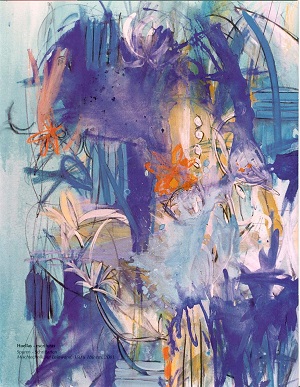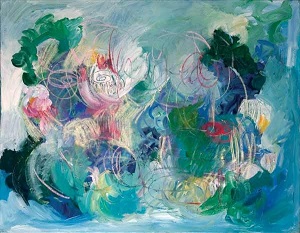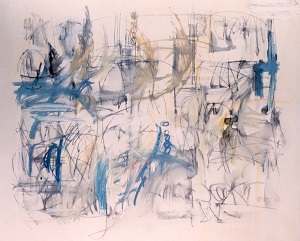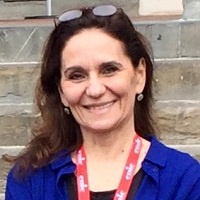Doing Psychoanalysis in... Buenos Aires, Argentina: Gabriela Goldstein
"I feel that art and psychoanalysis, are in some ways, the same 'thing'; each with its own rules and processes, but sharing much in common." Here, Gabriela Goldstein is interviewed by Angela Mauss-Hanke about her path as a painter, architect and psychoanalyst.

Gabriela, you are a painter, architect - and a psychoanalyst. Can you tell us about your professional path?
My encounter with psychoanalysis began early in life, almost from the beginning. Both of my parents were psychoanalysts and I had my own first analysis when I was a child. Years later, I trained to become a psychoanalyst at the
Argentine Psychoanalytic Association (APA), after a detour which I now consider enriching. To describe it, it would be best to tell you something about the influence of psychoanalysis in Buenos Aires. In the sixties, psychoanalysis was intertwined with local cultural life, together with the artistic avant-gardes and political and social commitment. This 'psychoanalytic world' was a unique experience. It was for me too, since my parents participated actively in this movement, which included the institutional life of the APA.
This context gave me lived experience of psychoanalysis in my youth besides my own analysis.
All this happened long before setting out on my training analysis in the APA and after graduating from university, first in Architecture, and later in Psychology. At that time I also started to work clinically in institutions, and to participate in supervision and study groups.
Can you tell us something about your experience as a candidate within APA?
Training in APA means 'full immersion' in psychoanalysis: clinical work, theory, and the intense institutional life which I immediately joined as a candidate. My participation in
IPSO as Vice President for Latin America inaugurated communication with colleagues in our institution and in other institutes and institutions around the world, exchanges which now continue in my work in the APA,
FEPAL and IPA.
The APA, founded in 1942, is a large institution whose singularity is what I would call a 'pluralistic tripod'; it has over a thousand members and candidates and is open to different psychoanalytic referential frames, with a major focus on Freudian seminars. This plurality constructs an open and enriching environment in which to think about clinical work. For over ten years, I've been a Member with Training Function in the APA, Training Analyst of the IPA and also Professor of Seminars of the APA's Institute, post-graduate courses in universities, and courses in psychoanalysis open to the community.
Besides all this you also work as an artist. Can you let us know about this path as well - and how these two areas come together inside of you and in your activities?
My career in art, as a painter, began before I finished architecture, a field I chose because of its affinity with aesthetics and art. Although I worked in architecture while I was finishing psychology, my desire was to paint. That was when my professional career began, with teachings and exhibitions of paintings in Argentina and later in other parts of the world. During the years of my training I was able to continue to exhibit my paintings, which somehow began to form a 'dialogue' with themes of psychoanalytic readings, in the form of shows I titled "Preliminary Writings" or "Project and Constructions" (playing with Freud's first and last works), among others. Sometimes an image led to a scientific work, as when I wrote on "la promesse du bonheur" ["the promise of happiness"] and male bisexuality: and at the same time organised an exhibition with the same title, but with abstract landscapes.

I feel that art and psychoanalysis, in some way, are the same 'thing'; each with its own rules and processes, but sharing much in common, aside from the concept of 'Techné', linked to art. My personal experience as a painter predisposes me to 'listening' in clinical practice to what we call 'actual pathologies': what emerges as an image on the edges of the speakable; also to the complex therapeutic paths in our practice in relation to what we commonly refer to as 'creativity'.

One last question: could you let us know something about the formation process of the video: "Approaches to the Feminine", which you created in 2018 - what does femininity mean to you?
This is a most interesting question. The next
IPA Congress is dedicated to all that interrogates such an enormous theme today. In this regard, when I was thinking about the many paths or roads to approach 'The Feminine', art and psychoanalysis came together again in the formation of my video. A contemporary Argentine artist, a woman, Nicola Constantino, came to mind. She seems to underscore and identify almost all the lines of work taken by Freud in
The Uncanny: the double, the gaze, the symbolic value of the eyes and the castration complex, Medusa's head, the automaton 'Olympia. 'Secret love affairs', the forbidden, leading to the intimate and to intimacy in the feminine appeared to me in paintings of Vermeer, Fragonard and others. The power of the images emerged in dialogue with ideas and concepts that led to other images of art, and they began to flow, in a kind of free 'play' association that allowed one Olympia to 'talk' to another one, evoking the image of Venus as utmost beauty in Botticelli and at the same time a prostitute in Manet, or the most primitive image of a primal woman, the Willendorf Venus; then, going on to the symbolic equation, motherhood, and creativity, the core of the feminine, and the discovery of Eros and Love. Freud's words in the text illuminate the images just as art incarnates ideas. I think and also like to investigate whether something about the feminine persists in his view; does it persist in other approximations in which we are immersed, such as gender debates, feminism, or other contemporary psychoanalytic approaches that question Freud's male perspective view? This is one question we ask. I think that art impinges on and refreshes this approach to the feminine: always enigmatic and open to debate in a new challenge.
 Gabriela Goldstein is a Training Analyst and Professor of Seminars in the Argentine Psychoanalytic Association (APA); full member of the International Psychoanalytical Association (IPA) since 2006. She has been a member of the IPA Committee on Psychoanalysis and Culture since 2007; a member of the Scientific Committee for Community and Culture, FEPAL, in 2014; a Representative on the APA Board 2009-2013. Founder and Chair of the APA Research Group on Art and Psychoanalysis.
Gabriela Goldstein is a Training Analyst and Professor of Seminars in the Argentine Psychoanalytic Association (APA); full member of the International Psychoanalytical Association (IPA) since 2006. She has been a member of the IPA Committee on Psychoanalysis and Culture since 2007; a member of the Scientific Committee for Community and Culture, FEPAL, in 2014; a Representative on the APA Board 2009-2013. Founder and Chair of the APA Research Group on Art and Psychoanalysis.
She has lectured at Latin American and international congresses, conferences, and universities on art and psychoanalysis, culture and subjectivity, as well as clinical research on the aesthetic experience, her main lines of exploration. Her Ph.D. thesis on "A Poetic Strangeness" investigated the effects of art on subjectivisation. She won the Mom-Baranger Prize for Best Monograph with "The Aesthetics of Memory, Freud at the Acropolis" and the A. Storni Prize for Conceptual Contributions in Psychoanalysis with "Transience, or the Time of Beauty". She published her book "The Aesthetic Experience: Writings on Art and Psychoanalysis" in 2005 with Editorial Del Estante in Buenos Aires. In 2013, she published and edited "Art in Psychoanalysis" in London with IPA-Karnac. She has also published articles in psychoanalytical journals and chapters of books.
She is both an architect and a painter, exhibiting her paintings in Argentina, Europe and the USA. She lives, practices, and paints in Buenos Aires.